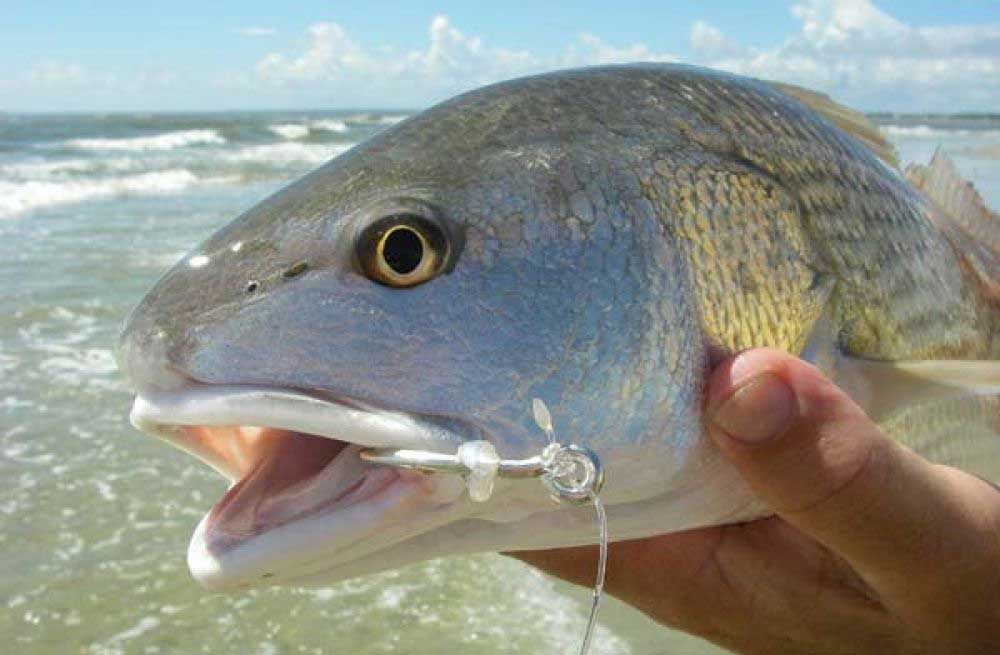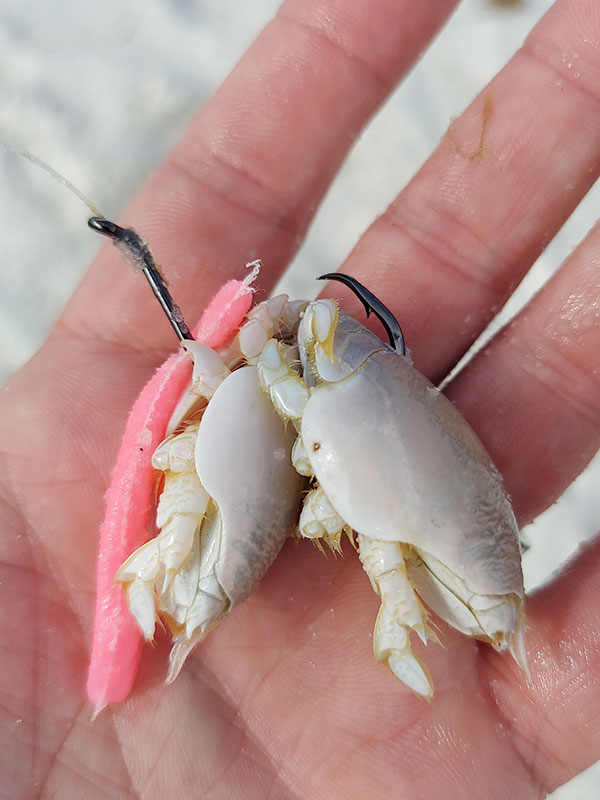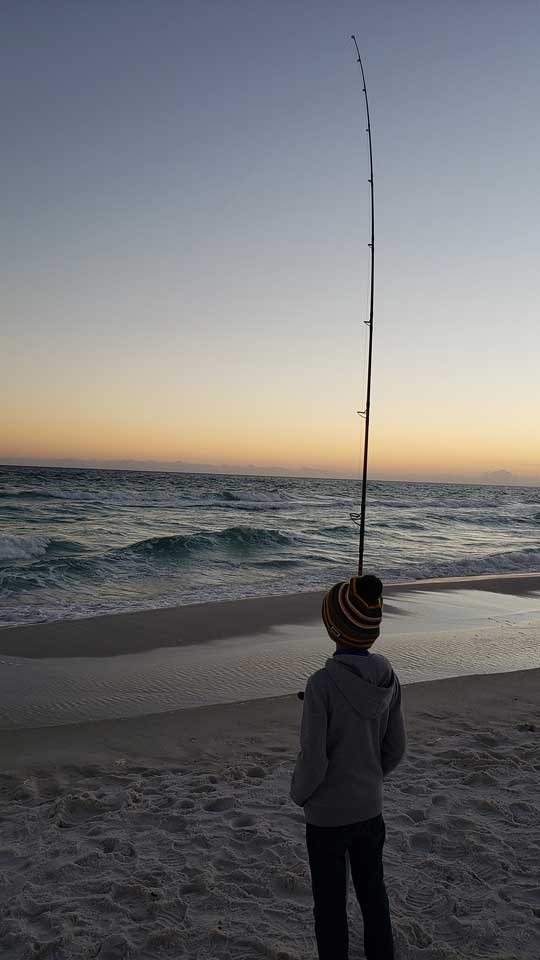 |
Redfish, Bull Reds, Slot Reds, Puppy Drum, or even just "Reds"... The list goes on and on. Red Drum, the official name of the species, are a fish of many names. From the coastal waters in the Gulf of Mexico to Hatteras Island and every bay in between, anglers up and down the coasts target these fish for their epic battles and their superb qualities as table fare.
Angling For Redfish of All Sizes
Of all the names this fish goes by, three of them are probably the most descriptive in terms of what you're up against. In order of size, these are Puppy Drum, Slot Reds, and Bull Reds. We'll get into rigging for these fish momentarily but lets first cover the who's who of Redfish.
Puppy Drum
As the name implies these are juvenile fish, and the term generally includes all fish below the lower slot length limit of 18 inches. These fish are generally less than two years old, and can be caught on relatively light tackle as long as you can get your presentation to them.
Slot Reds
These are your keeper fish. The 2020 Florida slot length limits allow you to keep Red Drum between the length of 18 inches to 27 inches. This limit has essentially been in place since 1989, and it is the reason we can still enjoy fishing for this species today. Fish within this slot limit will be two to three years old, and will generally weigh less than 10 Lbs. While pushing the limits for light tackle, you can still fill your bag with pretty modest gear. In Florida, Red Drum are regulated in three separate zones, so be sure to check your zone-specific regulations.
Bull Reds
Bull Reds are the big boys and girls of the bunch. These days a "Bull Red" is pretty much classified by any fish above the upper limit of the slot length of 27 inches. They are the breeders of the species and it makes sense for them to be protected. These fish have a tendency to use the surf against you by running parallel to shore while the waves are retreating, using the force of the water against their bodies to help them to stay off the sand and out of your hands. Combining this uncanny ability to time the waves with their own strength results in long fights that require heavier gear.
Basic Drum Rigs for Surf Fishing
Although not opposed to chasing down schools of baitfish, Red Drum are primarily bottom feeders, and most of the Redfish caught in the surf are taken off the bottom on modified fish finder rigs called "Drum Rigs". Redfish have large mouths and are generally not line or hook shy, so using large terminal tackle is common. Large circle hooks provide solid hookups, are safer for fish than traditional "J" hooks, and when combined with a heavy weight they are capable of setting themselves even on the hard jaws of large fish.
Even small Redfish can fit a 6/0 circle hook in their mouths, so that is a good starting point when targeting this species. If your solely after big bull reds, you can upsize all the way up to 10/0 or even larger, however doing so will limit your chances on some other species.
Hook size aside, the next biggest difference in drum rigs is how long of a leader you use. As previously mentioned, these fish are not excessively line shy, so the length of the leader is primarily for presentation and whether the angler wants to allow, or not to allow movement of their bait.
The absolute simplest rig you can use is made by just adding a sliding pyramid weight on your main line prior to tying on a heavy duty (100lb) snap swivel that will be attached to the aforementioned large circle hook. This keeps the bait directly on the bottom with no extra movement of your presentation. This rig works well provided your main line (or shock leader, if tied on) is of high enough test.
More common rigs have a short length of heavy monofilament tied to a heavy swivel and snelled to an 8/0 to 10/0 circle hook. 60 to 100 pound mono is commonly used since it's plenty abrasion resistant and stout enough to horse in a big fish while still being tie-able. Going much larger than 100 lb. test on your leader usually results in the use of crimps, which is fine, but it's one more tool that you must purchase. The length of this leader can range anywhere from 3" to a few feet, but the main goal is to keep your bait anchored on or very near to the bottom, so shorter leaders are often employed. A one foot long leader is a great place to start.
Redfish Bait
 |
As we mentioned, Drum are primarily bottom feeders. Their diet consists of clams, crabs and other crustaceans as well as whatever falls to the bottom of the sea. One of the best baits for catching Redfish from the surf are Sand Fleas (Mole Crabs). These can be caught fresh or purchased frozen, and rigged on a circle hook. Fresh Sand Fleas stay on the hook far better than their frozen counterparts. Cut baits also work well for Redfish, with squid, blue crab, shrimp and cut mullet being popular. Fresh caught Ladyfish also works wonders for Catching Redfish as well as other more toothier species (sharks), but it does not freeze well. Live bait also works as long as you keep it pinned near the bottom. Most all of these baits will produce a variety of by-catch as well, so don't be surprised if you drag in Bluefish, catfish, or even small sharks (large sharks will probably just bite through your leader / line).
Lures & Spoons For Red Drum
Although the use of lures is not as common as cut or live baits when surf fishing, there are still a variety of lures that will catch fish. This is particularly effective if you manage to find a school of Redfish that you can sight cast to. Rat-L-Traps, MirrOlure's, and Silver and Gold Spoons all work well for this since they can be cast accurately to long distances. If the fish are schooling up and you can see birds following them, it's a tell tale sign to start casting baitfish-imitating lures right to them as the Redfish are chasing baitfish and will be ready to hit just about anything flashy.
Best Times to Surf Fish for Redfish
 |
Sunrise and sunset. There is no reason you can't catch fish throughout the day, but sunrise and sunset are hands down the most active feeding periods for fish, Reds included. Large fish are more comfortable coming in close to shore during dusk and dawn when it is harder for them to be seen. These low-light periods are some of the best times to be on the beach soaking baits since more fish will be within casting distance, often the limiting factor for surf anglers. If you time your trips right, fishing at sunrise and sunset during a tidal change will be your best bet since both of these are prime fishing events. A word of warning - pretty much all species get a little closer to shore at nighttime, sharks included, so be careful and don't be surprised with some impressive unplanned catches.
Red Drum Fishing Seasons
With the exception of the area between Pasco-Gordon Pass and Collier counties where Red Drum are Catch and Release only, there are no other closed seasons in the Atlantic and Gulf regions of Florida for Hook and Line fishing at the time of writing. Gigging, spearing and snatching are all prohibited.